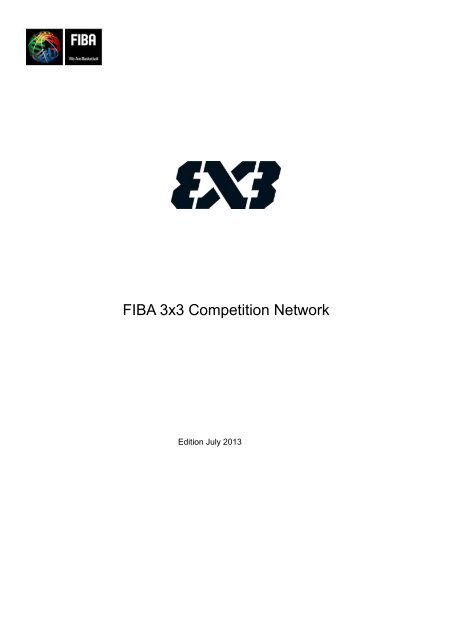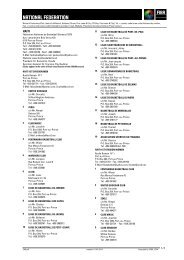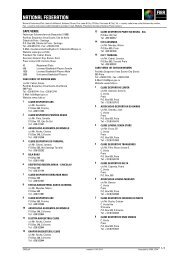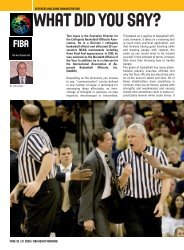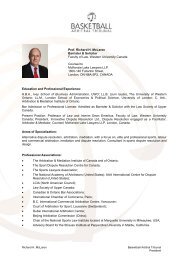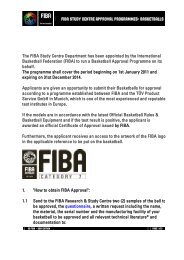Download - Fiba
Download - Fiba
Download - Fiba
Create successful ePaper yourself
Turn your PDF publications into a flip-book with our unique Google optimized e-Paper software.
FIBA 3x3 Competition Network<br />
Edition July 2013
Table of Contents<br />
0. Preamble ...................................................................................................... 3<br />
1. Executive Summary ..................................................................................... 4<br />
1.1. Integrated Competition Network.................................................................. 4<br />
1.2. Endorsement process ................................................................................. 5<br />
1.3. Competition Network’s hierarchy ................................................................ 7<br />
1.4. 3x3 Global Season ..................................................................................... 9<br />
2. Grassroots and 3x3 Tours .......................................................................... 11<br />
2.1. Age categories .......................................................................................... 11<br />
2.2. 3x3 Tours ................................................................................................. 11<br />
2.3. NFs’ role regarding grassroots and 3x3 Tours .......................................... 12<br />
3. FIBA 3x3 World Tour.................................................................................. 14<br />
3.1. Introduction ............................................................................................... 14<br />
3.2. Format of WT Events ................................................................................ 16<br />
3.3. FIBA 3x3 World Tour Competition Format ................................................ 16<br />
3.4. WT Qualifiers ............................................................................................ 16<br />
3.5. WT Qualifiers’ Contract ............................................................................. 18<br />
4. National Team Competitions ...................................................................... 20<br />
4.1. FIBA 3x3 World Championships ............................................................... 20<br />
4.2. Global Champs’ Action Plan .................................................................... 23<br />
4.3. FIBA Champs’ Competition Format .......................................................... 23<br />
4.4. Frequency / Calendar ............................................................................... 24<br />
4.5. Host City / Venue Location ....................................................................... 24<br />
FIBA 3x3 Competition Network_Edition 2013_July<br />
Page 2 of 24
0. Preamble<br />
The first version of this Concept Paper was presented and discussed during the 3x3<br />
Global Workshop held on 13 and 14 October 2012 in Barcelona; and submitted to<br />
FIBA’s Central Board in November 2012. This second version includes all relevant<br />
updates concerning the 2013 season.<br />
This Concept Paper is at disposal of National Federations (“NFs), organizers and<br />
stakeholders in general in order to guide and explain FIBA’s steered 3x3 Competition<br />
Network.<br />
FIBA 3x3 Competition Network_Edition 2013_July<br />
Page 3 of 24
1. Executive Summary<br />
1.1. Integrated Competition Network<br />
FIBA has launched an integrated competition network (“3x3 Competition Network” or<br />
“Competition Network”) to further structure and develop 3x3.<br />
The FIBA-steered 3x3 Competition Network will only include FIBA-endorsed 3x3<br />
events. Any 3x3 event anywhere in the world can become FIBA-endorsed, if its<br />
organiser signs and complies with the 3x3 Endorsement Terms 1 .<br />
The most relevant endorsement conditions are:<br />
Use of FIBA 3x3 rules of the game;<br />
Share player’s data and event result with 3x3planet.com<br />
Use of FIBA’s tournament software tool, FIBA 3x3 EventMaker;<br />
Ensure that all participating players are registered at 3x3planet.com;<br />
Grant FIBA royalty-free licence to amend, use and distribute footage and<br />
images from the event without restrictions and holding FIBA harmless from any<br />
related claim;<br />
Allow FIBA to publish the results of the event on 3x3planet.com and to use data<br />
for calculation of 3x3 Individual World Rankings;<br />
Prize money aligned with FIBA’s guidelines; no FIBA-endorsed event is allowed<br />
to award more prize money then WT events.<br />
The main endorsement requirement to be fulfilled by a competition is to have all its<br />
participating players registered at 3x3planet.com, FIBA’s digital platform for 3x3.<br />
Rationale:<br />
3x3 Competition Network is about creating an integral competition network and<br />
offering an individual global ranking – therefore it is mandatory to sign up<br />
players and events at 3x3planet.com to ensure FIBA is capturing the data.<br />
1 Check in fiba.com/3x3/downloads<br />
FIBA 3x3 Competition Network_Edition 2013_July<br />
Page 4 of 24
All 3x3 FIBA-endorsed events will become automatically part of the 3x3 Competition<br />
Network, all their relevant data will be centrally stored in 3x3 Planet and used for<br />
ranking purposes as well as individual dashboards.<br />
1.2. Endorsement process<br />
FIBA’s freeware to manage events, EventMaker, has automated the endorsement<br />
process.<br />
FIBA 3x3 Competition Network_Edition 2013_July<br />
Page 5 of 24
Once an organiser has registered, it is automatically certified and can organise an<br />
unlimited number of tournaments. Only caveat: a national federation can ask FIBA to<br />
de-certify an organiser on sound reasons, e.g. no adhering to FIBA’s code of ethics.<br />
A certificated organiser will have its event automatically endorsed whe using the<br />
EventMaker.The automated endorsement process:<br />
The 3x3 Endorsement Terms are a standard adhesion contract.<br />
Only FIBA-endorsed events are allowed to use the 3x3 Endorsed Event stamp and no<br />
organizer/event is allowed to use the FIBA 3x3 logo.<br />
FIBA 3x3 Competition Network_Edition 2013_July<br />
Page 6 of 24
1.3. Competition Network’s hierarchy<br />
The FIBA-endorsed events nomenclature is the following:<br />
FIBA 3x3 World Tour: A 3x3 competition organised under supervision of FIBA<br />
and comprised of several FIBA 3x3 World Tour Masters (“WT Masters”) and<br />
one FIBA 3x3 World Tour Final (“WT Final”), with 12 teams participating in each<br />
event, whereas each team represents a city and rosters are freely composed by<br />
players without nationality restrictions (“WT” or “World Tour”). The WT is FIBA’s<br />
flagship and the heartpiece of the Competiton Network.<br />
3x3 World Tour Qualifier: A 3x3 competition organised by a FIBA-designee<br />
where at least one team will qualify for a FIBA 3x3 World Tour Masters in the<br />
corresponding catchment area (“WT Qualifier”); there are two kind of WT<br />
Qualifiers: Quests and Challengers.<br />
3x3 Quest: A WT Qualifier comprised of at least three events, including a final,<br />
each with at least 50 participating teams in all categories, being open to<br />
anybody.<br />
3x3 Challenger: A WT Qualifier comprised of one stand-alone, invitational<br />
international tournament limited to 16 teams with obligatory prize money.<br />
Feeder: A Feeder is a 3x3 Tour or single event that is part of the “Path to the<br />
World Tour” but yet too small to become a WT Qualifier – therefore winning<br />
teams of these events are directed by FIBA to suitable 3x3 Challengers.<br />
FIBA 3x3 World Championships: A 3x3 competition organised by FIBA,<br />
whereas the competing teams represent an affiliated FIBA member and rosters<br />
are selected by the corresponding National Federation (“3x3 WC”).<br />
All other 3x3 Tours or single tournaments are simply “endorsed events” and are also<br />
linked to the 3x3 Competition Network, but are not on the “Path to the World Tour”,<br />
albeit teams could potentially classify via wild cards in case of a high ranking.<br />
FIBA 3x3 Competition Network_Edition 2013_July<br />
Page 7 of 24
All FIBA-endorsed events are classified in the 3x3 Competition Network hierarchy as<br />
follows:<br />
Therefore, the 3x3 Competition Network is a bottom-up integrated hierarchy that<br />
includes all FIBA-endorsed events from grassroots to elite competitions, such as the<br />
3x3 World Tour and national team championships.<br />
FIBA 3x3 Competition Network_Edition 2013_July<br />
Page 8 of 24
The elite competitions can be split into two types:<br />
National Team championships;<br />
City-based WT.<br />
The top National Team competitions are the FIBA 3x3 World Championships (“WC”)<br />
and FIBA 3x3 U18 World Championships (“U18WC”). National Federations are<br />
responsible to select the national teams. Further National Team competitions include<br />
inter alia FIBA Zone Championships, IOC-organised competitions and FISU World<br />
University Championships.<br />
The FIBA 3x3 World Tour is a series of events supervised by FIBA, consisting of a<br />
series of “WT Masters” and a “WT Final”. The participating teams have no nationality<br />
restrictions and represent a city. The teams participating in a WT Masters have<br />
qualified through FIBA-designated WT Qualifiers in each WT Master’s corresponding<br />
catchment area; the WT Final is comprised of teams that have qualified at the relevant<br />
WT Masters.<br />
The number of teams that will qualify for the WT Final from each WT Master as well as<br />
the selection of the WT Qualifiers themselves are a FIBA prerogative. In the 2013<br />
edition of the WT the best 2 teams of each of the 5 WT Masters proceed to the WT<br />
Final, complemented with one local team and one wild card for a total of 12 teams.<br />
The FIBA 3x3 World Tour Event Manual, developed by FIBA alongside its FIBA 3x3<br />
World Tour operating partners, will regulate the elite events to ensure quality standards<br />
and common look & feel in 2013. The elite events should whenever possible, be held in<br />
conjunction with grassroots competitions, in keeping with the 3x3 spirit of « everybody’s<br />
game ».<br />
1.4. 3x3 Global Season<br />
The goal of a unified 3x3 Global Season is to avoid agenda conflicts between the main<br />
National-Team championships and the WT, as well as timing the various events to<br />
minimise diversion from other sports. The WT Masters ought to be the pinnacle of each<br />
catchment area’s natural season.<br />
FIBA 3x3 Competition Network_Edition 2013_July<br />
Page 9 of 24
WC, U18WC and FIBA Zone championships should be held before the start of the WT.<br />
The WT season will start every year at the end of the 2nd quarter and finish around the<br />
end of 3rd quarter with the WT Final; the WT Qualifiers in each catchment area will<br />
have to be aligned accordingly, to allow for an optimal qualification process.<br />
Rationale: The WT Masters are played continuously over several months during<br />
the “outdoor season” to draw players, audience and media attention. Timing of<br />
WT Masters can be changed according to geographic placement in order to fit<br />
with the local 3x3 season.<br />
FIBA 3x3 Competition Network_Edition 2013_July<br />
Page 10 of 24
2. Grassroots and 3x3 Tours<br />
All grassroots events, even pick-up games, can be part of the 3x3 Competition<br />
Network. Any organiser can stage a 3x3 grassroots event; the most basic ones can be<br />
organised by schools and local communities, while 3x3 Tours, the most sophisticated<br />
3x3 events, tend to be organized by national federations or professional promoters,<br />
including sponsors.<br />
2.1. Age categories<br />
Organisers are free to decide the various categories for their 3x3 events: age, height,<br />
gender and proficiency are various categories currently used by organisers.<br />
FIBA recommends the following age categories for both male and female:<br />
Senior or open (18+);<br />
Youth (U18);<br />
Kids (U15);<br />
35+; U12.<br />
Initially, FIBA will organise events in the open and U18 category for both genders.<br />
2.2. 3x3 Tours<br />
3x3 Tours are currently one of the pillars of 3x3 basketball and should be fostered as<br />
one of the routes for the expansion of the discipline.<br />
3x3 Tours are competitions based on a series of linked tournaments and whose main<br />
traits are as follows:<br />
Each tournament has at least 50 participating teams for all categories combined. A tour<br />
has a minimum of three linked tournaments with a tour winner. These 3x3 Tours can be<br />
single city, i.e. a series of tournaments in one city, or multi-city ones, i.e. a series of<br />
tournaments staged in several cities. The typical format of competition is Round Robin<br />
followed by single elimination.<br />
A country can host several 3x3 Tours managed by different organisers.<br />
FIBA 3x3 Competition Network_Edition 2013_July<br />
Page 11 of 24
FIBA strongly recommends focusing on the development of single-city tours in order to<br />
create 3x3 clusters. The ranking works best with data generated by clusters; it also<br />
helps to strengthen the community features of 3x3 Planet and follows Powell Doctrine<br />
pursuant effort efficiency.<br />
Teams participating in 3x3 Tours have no nationality-restrictions. Teams are free to<br />
form within the categories’ established by the tour organizer.<br />
Organisers of 3x3 Tours can be schools, universities, national federations, private<br />
promoters, brands, etc. All of them need to undergo the endorsement process by FIBA<br />
in order to have their tournament part of the 3x3 Competition Network. The best 3x3<br />
Tours can become a WT Qualifier as explained in section 4.4.<br />
3x3 Tours also have relevance for National Team competitions. Only national<br />
federations with a 3x3 Tour in their country will be invited to participate in the Zone<br />
Qualifications for World/U18 World Championships; therefore only national federations<br />
with an endorsed 3x3 Tour in their territory will be allowed to participate in World/U18<br />
World Championships and Zone Championships.<br />
2.3. NFs’ role regarding grassroots and 3x3 Tours<br />
Although 3x3 is a promoter-driven discipline, the role of national federations is still<br />
important in ensuring its development. The national federations should:<br />
Appoint a dedicated 3x3 person within its organisations;<br />
Sanction for FIBA the various promoters and tournaments in their territory which<br />
comply with FIBA’s “general terms and conditions” (refer section 1.1);<br />
Encourage the organisation of 3x3 events with a specific focus on 3x3 Tours.<br />
The role of National Federations is key in developing 3x3 Tours.<br />
Several national federations are already leveraging the power of 3x3 Tours to develop<br />
basketball in their countries.<br />
FIBA 3x3 Competition Network_Edition 2013_July<br />
Page 12 of 24
Some benefits for national federations developing or supporting 3x3 Tours:<br />
Powerful tool to develop 3x3 basketball;<br />
Method of growing the number of players;<br />
Prerequisite to participate in FIBA 3x3 World Championships, FIBA 3x3 U18<br />
World Championships and Youth Olympic Games, as well as in the qualifiers<br />
for those events;<br />
Optimal method to increase chance of participating in national-team<br />
competitions.<br />
FIBA is encouraging all National Federations to support and further develop 3x3 Tours<br />
in their countries. There are several routes a National Federation can pursue in order to<br />
have 3x3 Tours in their countries:<br />
Support incumbent promoters;<br />
Stimulate new promoters;<br />
Foster 3x3 in educational centers (e.g. schools, universities) and communities;<br />
Organise 3x3 Tours themselves.<br />
FIBA 3x3 Competition Network_Edition 2013_July<br />
Page 13 of 24
3. FIBA 3x3 World Tour<br />
3.1. Introduction<br />
The World Tour consists of five sequential WT Masters leading to a WT final combining<br />
the best teams of the five WT Masters events. The 2013 edition has the following<br />
sequence:<br />
The general layout and timing of the FIBA 3x3 World Tour will stay unchanged,<br />
however an increase of WT Masters overtime can be expected. The underlying<br />
principle of the WT is to give every year any 3x3planet.com-registered player the<br />
chance of participating.<br />
FIBA 3x3 Competition Network_Edition 2013_July<br />
Page 14 of 24
The WT Master represents a geographic catchment area and should feature its best<br />
3x3 players. The WT Masters hosting cities are selected with the goal to cover the<br />
world; final selection is FIBA’s prerogative. WT stages will always be related to a city<br />
and its catchment area will cover several countries and even cross continental<br />
boundaries.<br />
The WT is synchronised with 3x3 National Team championships, and will try to avoid<br />
conflict with other major basketball events and other major sport events wherever<br />
possible.<br />
Although 3x3 is an all-year discipline, it is preferentially played outdoors. Therefore the<br />
main season in each region tends to finish at the end of its summer period. The WT<br />
Masters in each catchment area should take its 3x3 season into account and be held at<br />
the end of the good weather season insofar possible.<br />
The catchment areas in 2013 are as follows:<br />
Rationale:<br />
Overall goal of the World Tour is to reach out to as many players and fans from<br />
different countries and cities as possible. Timing is chosen to maximise playing<br />
outdoors.<br />
FIBA 3x3 Competition Network_Edition 2013_July<br />
Page 15 of 24
3.2. Format of WT Events<br />
The FIBA 3x3 World Tour Masters are typically weekend events with two days of<br />
competition and packed with side events. A standard of 12 teams will participate in the<br />
elite category, whilst an adjacent recreational competition with circa 50 teams in very<br />
much intended.<br />
The 12 teams in each World Tour event will be selected via ex-ante designated<br />
qualifiers in the related catchment area. Whilst registration to the parallel amateur<br />
competition will not be restricted except for a number of teams cap, if any.<br />
The events are meant to offer more than just sport competition and should be<br />
organized as a full weekend experience with contests, music, shows to enjoy and<br />
interactive side events that appeal to a family as well as a group of friends of any age.<br />
3.3. FIBA 3x3 World Tour Competition Format<br />
The standard competition format of a World Tour event will be round robins followed by<br />
knock-outs: 12 teams competing in pools of four for with the best 2 of each pool and<br />
the two best 3 rd progressing to the quarterfinals.<br />
The two best teams of each WT Masters and two wild cards classify to the WT Final for<br />
the overall title.<br />
In addition, the WT events will have a shootout and dunking contest.<br />
The growth of 3x3 should lead to circuits in the various catchment areas, whereas a<br />
given catchment area has a certain number of WT Masters and therefore becoming a<br />
catchment area’s circuit events.<br />
In order to attract the best players, prize money is offered at the World Tour events.<br />
3.4. WT Qualifiers<br />
The teams competing in each WT Masters are representing a city and will have earned<br />
a berth competing at events in the relevant catchment area. A WT Qualifier is defined<br />
as an event or tour that secures at least one participating team a place in a WT Master.<br />
In addition, FIBA reserves the right to invite additional teams/players based on the 3x3<br />
Ranking and via wild cards.<br />
FIBA 3x3 Competition Network_Edition 2013_July<br />
Page 16 of 24
Although teams and players are not barred from competing in various catchment areas<br />
and WT Qualifiers, the competition system does not foresee the participation in more<br />
than one WT Masters in case of multiple successful qualifications. The rationale behind<br />
this is to keep a maximum variety of teams in the World Tour and offer the participation<br />
as development driver in all catchment areas for the time being. In addition, teams<br />
qualified for a WT Masters must consist of at least the team captain and one other<br />
player from the team winning the relevant WT Qualifier. 2 players max may be replaced<br />
in case of injury, but only by players that have participated in at least two FIBA-<br />
endorsed events in the same catchment area during the last 12 months.<br />
In order to secure a fair representation of the catchment areas in the World Tour,Teams<br />
are allowed to participate in any event including Challengers. Said this, a WT Masters<br />
event will only feature the teams of its catchment area. Winner of a WT Qualifier that<br />
does not belong to its catchment area, will not qualify to the given WT and only collect<br />
the points; the best placed team of the right catchment area will get the berth.”<br />
FIBA determines the WT Qualifiers. WT Qualifiers for each WT Masters are assigned<br />
based on two criteria:<br />
1. Results of previous season results in the respective WT Masters<br />
The organisers of the WT Qualifiers whose teams finished in the top six of a<br />
WT Masters receive a direct slot for the WT Masters the following year<br />
2. Class, mass and CSR angle of an organiser<br />
Tradition and venue location;<br />
Sustainability and quality of the organiser;<br />
Size, number of participants and spectators;<br />
Age and gender diversity; quality of the registered players;<br />
Footprint across the catchment area;<br />
Prize money; side events; overall event quality;<br />
More than one team can be allocated to a WT Masters from a given WT Qualifier, if a<br />
tournament/tour is of high quality and/or covers a large geographical region and/or<br />
follows all FIBA recommendations.<br />
FIBA 3x3 Competition Network_Edition 2013_July<br />
Page 17 of 24
WT Qualifiers can be organised by a National Federation, a private promoter, a<br />
commercial sponsor, a city, a university, etc.; all interested candidates will be evaluated<br />
by FIBA and have to undergo a review process.<br />
The WT Qualifiers can be either:<br />
A “3x3 Quest”. This is a 3x3 Tour that has been elevated to WT Qualifier status,<br />
due to its quality and size;<br />
A “3x3 Challenger” (also called “Open” in some Eastern European countries).<br />
This is an invitational, international, stand-alone, yearly tournament featuring<br />
the best teams of a given region with obligatory prize money.<br />
Organisers interested in staging a 3x3 Quest and/or 3x3 Challenger will have to submit<br />
their interest and candidature to FIBA for its consideration.<br />
Equipment, especially the courts and hoops, ought to follow FIBA requirements in<br />
particular regarding the safety standards – relevant guidance is provided in the Event<br />
Manual as well as by the FIBA Equipment & Venue Center’s documentation.<br />
Except for these requirements, organisers are free to conduct their event as best suits<br />
their needs. FIBA will not be involved financially in the WT Qualifiers.<br />
3.5. WT Qualifiers’ Contract<br />
Organisers of a WT Qualifier will have to sign with FIBA a contract covering the<br />
following contractual clauses:<br />
Sign the Terms & Conditions for 3x3 WT Qualifiers;<br />
Align, in advance with the FIBA’s season calendar;<br />
Allow FIBA to promote the WT Qualifier and use content related to it;<br />
Use of EventMaker and have all participants registered in 3x3planet.com;<br />
Use a FIBA 3x3 official ball, if any; and use FIBA rules;<br />
Fund travel of qualified team(s) to the corresponding WT Masters<br />
3x3 Challengers to award USD 5.000 in prize money;<br />
Follow FIBA lead on sports-related matters, such as inter alia, appointment of<br />
referees, commissioners and supervisor, if required;<br />
FIBA 3x3 Competition Network_Edition 2013_July<br />
Page 18 of 24
Proper use of FIBA logo and compliance with FIBA branding guidelines.<br />
FIBA 3x3 Competition Network_Edition 2013_July<br />
Page 19 of 24
4. National Team Competitions<br />
In spite of being a young discipline, there are already a significant number of National<br />
Team competitions.<br />
The main National Teams competitions are:<br />
FIBA 3x3 World Championships;<br />
FIBA 3x3 U18 World Championships;<br />
European Olympic Games;<br />
Youth Olympic Games;<br />
Zone Championships;<br />
All these National Team competitions comply with the endorsement requirements and<br />
are part of the 3x3 Competition Network.<br />
In addition, there are a number of other National Team competitions, such as FISU<br />
World University Championships organized with FIBA’s technical cooperation; those<br />
competitions are part of the3x3 Competition Network if they comply with the<br />
endorsement criteria.<br />
4.1. FIBA 3x3 World Championships<br />
The two main National Team competitions organized by FIBA are:<br />
FIBA 3x3 U18 World Championships;<br />
FIBA 3x3 World Championships.<br />
The following sections mainly refer to those two events, but most of the features are<br />
applicable to or are recommended for other national team competitions.<br />
FIBA is converging the format and size of WC and U18 WC (together “FIBA Champs”)<br />
to facilitate replication and standardisation of the events. Qualification system, eligibility<br />
and applicable regulations will be same for both.<br />
FIBA Champs have to have simultaneously men and women’s team competition and a<br />
series of individual contests. FIBA is developing a FIBA Champs Event Manual.<br />
FIBA 3x3 Competition Network_Edition 2013_July<br />
Page 20 of 24
Rationale for individual contests:<br />
Individual contests will supplement the main tournament, add more highlights,<br />
give more chances to win medals, strengthen group dynamics, fit with the<br />
streetball culture and add to the entertainment for audiences.<br />
4.1.1. Eligibility and qualification system<br />
In order to be eligible to participate in FIBA Champs, Zone championships and IOC-<br />
organized competitions (“Global Champs”), National Federations are required to have<br />
three FIBA-endorsed events in their territory in the previous 12 months up to a<br />
determined cut-off date 2 .<br />
Eligible countries have three routes to qualify:<br />
1. Host Country is awarded a place;<br />
2. Previous tournament edition: The Winner of the previous (U18)-WC/OG qualifies<br />
directly to the next edition 3 ; in case this team is the host country, then the second<br />
ranked team qualifies;<br />
3. Position in FIBA 3x3 national federation forced ranking.<br />
The National Federation forced ranking has a cutoff date November 1 st of each year for<br />
June WC the following year. Details on the ranking to be found in the “Criteria to<br />
Qualify for NT” and the “Ranking Quick Guide” document on the hub on<br />
fiba.com/3x3/downloads.<br />
The FIBA 3x3 national federation ranking is calculated as follows:<br />
2 Cut-off date is 1 November (end of season) of prior year for FIBA Champs<br />
3 Youth Olympic Games are considered U18 Championships; whilst Olympic Games are considered World<br />
Championships<br />
FIBA 3x3 Competition Network_Edition 2013_July<br />
Page 21 of 24
All national federations meeting the eligibility norm are force-ranked (from highest<br />
to lowest) in accordance with the ranking points awarded on 3x3Planet.com to the<br />
individual playes. Each national federation’s total ranking points are equal to the<br />
sum of points earned by all respective nationals within the world top 1000 players<br />
on 3x3Planet.com. This calculation is done separately for Men, Women, U18 Men<br />
and U18 Women.<br />
In the event of a tie, the national federation with the highest number of ranking<br />
points in the respective age and gender will qualify. Should there still be a tie, then<br />
the national federation with the highest number of all-categories ranked nationals<br />
will qualify.<br />
Without influencing the right of participation for countries qualified via route 1 or 2 ;<br />
the final selection via route 3 is subject to three restrictions:<br />
(i) a ratio of participating teams/countries no higher than 1.33* ,<br />
(ii) a maximum of 50% of total teams coming from the same FIBA Zone , and<br />
(iii)a minimum of one team per FIBA Zone.<br />
*If the ratio is not met, for countries with both genders pre-selected, the worst<br />
ranked, either male or female, is being substituted by the next ranked country until<br />
the ratio is reached.<br />
4.1.2. Eligible players<br />
Only 3x3planet-com registered players that have played at least in two FIBA-endorsed<br />
events in the 12 months prior to the date of roster selection will be able to join the<br />
national team pursuant Global Champs.<br />
Rationale:<br />
Registration at 3x3planet.com is important to grow the 3x3 community also<br />
amongst national-team players; particularly to allow players to be ranked and<br />
compared, but also to demonstrate a participation pathway for the grassroots<br />
players.<br />
4.1.3. Team roster<br />
Team rosters will consist of four players; only one delegation official per team.<br />
FIBA 3x3 Competition Network_Edition 2013_July<br />
Page 22 of 24
Roster composition is decided by the National Federation. FIBA highly recommends<br />
taking the 3x3 Individual World Ranking into consideration and reserves the right to<br />
issue regulations to this effect in the future.<br />
4.2. Global Champs’ Action Plan<br />
The qualification system developed by FIBA is biased towards the national federation<br />
ranking; most of the teams qualified to Global Champs thanks to their ranking position.<br />
National Federations can increase their chances to participate in Global Champs by<br />
developing actions aimed to improve their position in the national federation ranking.<br />
The following actions are the very much recommended when intending to improve the<br />
national federations ranking:<br />
- Maximize the number of ranked players registered in 3x3planet.com<br />
- Maximize the total ranking points of all its national players<br />
- Maximize the number of FIBA-endorsed events in its territory<br />
- Maximize the number of FIBA-endorsed 3x3 Tours in its territory by stimulating the<br />
highest number of organisers<br />
- Have best ranked nationals participating in both higher level events and national-<br />
team competitions<br />
- Facilitate the inclusion of competitions in the “Path to the World Tour”, either as<br />
feeders or WT Qualifiers<br />
4.3. FIBA Champs’ Competition Format<br />
FIBA Champs consist of:<br />
Team Competitions, always simultaneously both men and women;<br />
Individual contests.<br />
The main attraction will be the size and format of the team competition, as it will<br />
consume significantly more time than the individual contests. The players participating<br />
in the individual contests will be drawn from the participants in the national teams.<br />
FIBA 3x3 Competition Network_Edition 2013_July<br />
Page 23 of 24
4.4. Frequency / Calendar<br />
FIBA Champs are to be held in June: WC will take place every even year whilst the<br />
U18 WC yearly unless it is a Youth Olympic Games (YOG) year – in this case the YOG<br />
replaces the U18WC.<br />
This schedule of national-team competitions will grow as more international federations<br />
and associations include 3x3 in their programme, e.g. SportAccord Urban Games.<br />
4.5. Host City / Venue Location<br />
FIBA is in charge of the designation of 3x3 WC and 3x3 U18WC host cities.<br />
The host selection process is decided by FIBA on a case-by-case basis and can be<br />
either discretional or via tender.<br />
All related travel costs to the 3x3 WC and 3x3 U18WC hosting country for teams and<br />
officials will be borne by each participating National Federation; while local travel &<br />
living for up to five people per delegation, as well as customary event organisation<br />
expenses, will be covered by the LOC.<br />
Venues should be outdoors and downtown in iconic high-traffic areas. Further details<br />
will be included in the FIBA Champs manual.<br />
END.<br />
FIBA 3x3 Competition Network_Edition 2013_July<br />
Page 24 of 24


